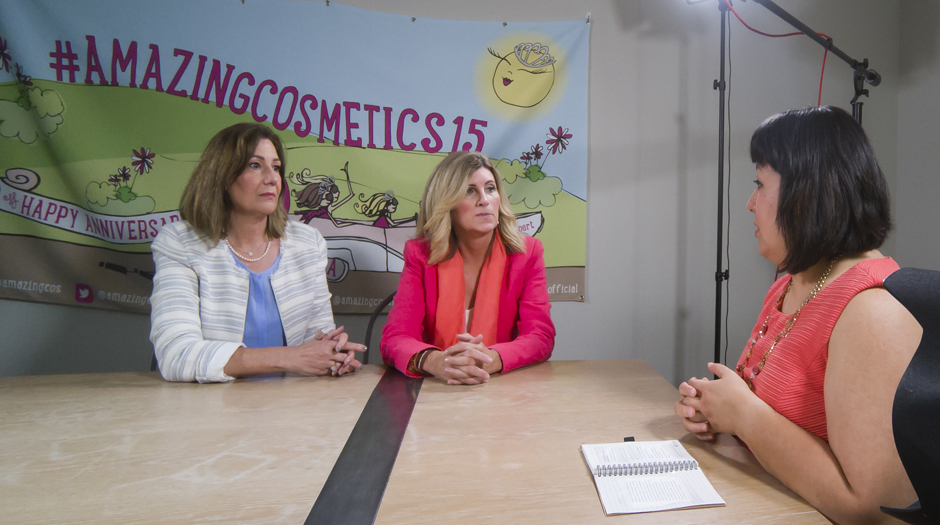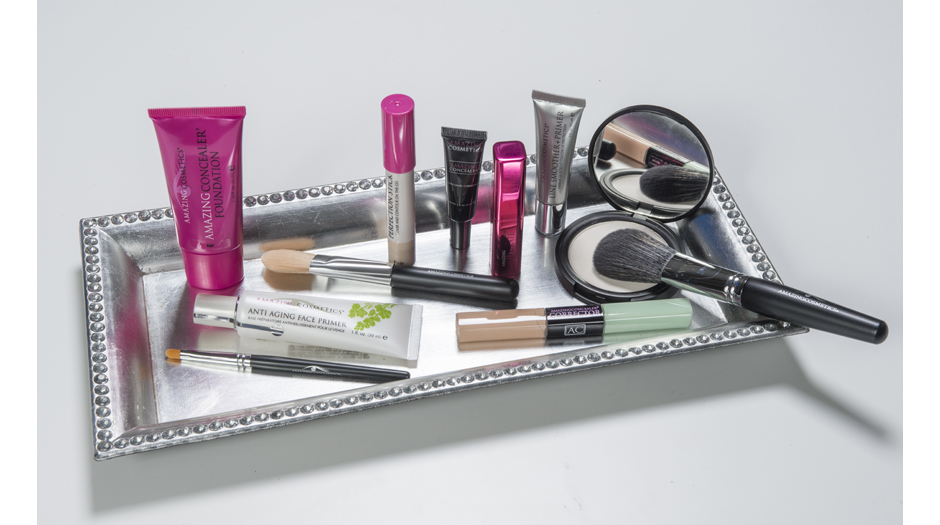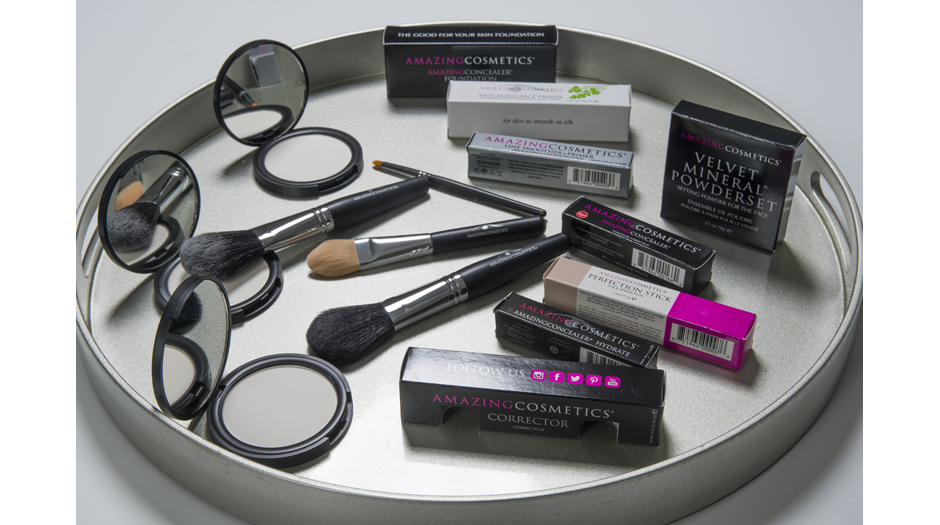Education
CXO Series: Disrupting the Cosmetics Market
Published
7 years agoon
By
BXP StaffWHEN SHE WAS a child, Lisa Thurman wanted to dive off cliffs and race cars. Today, she’s taking leaps daily as co-founder and CBO (chief beauty officer) of Amazing Cosmetics. Together with fellow co-founder, Sue Katz, CFO (chief flawless officer), they are using innovation, collaboration and smart marketing and design to deliver confidence to women and men daily.
The origins of their company started nearly 20 years ago, when Internet shopping was nascent. A June 2000 Pew Research Center survey found that less than a quarter of Americans (22%) surveyed had made a single purchase online. Katz and Thurman used this burgeoning technology to address what Katz, in her work as a makeup artist, saw a hole in the cosmetics industry offerings.

“Concealer was not even a well-used product or term 20 years ago,” Katz recalls. “It just wasn’t really thought of because it wasn’t the sexy purple eye shadow or the beautiful fuchsia lipstick. But we knew as women, who don’t wake up with perfect completions—not that we have major flows—but we definitely need makeup. We felt there were a lot of other people like us, who wanted to look like that girl who woke up with perfect skin.”
Thurman adds, “At the time, concealer was a ‘by-the-way’ offering and it came in just three shades.” Katz explains, “Shade ranges are extremely important because if you have the wrong shade you are going to see it on your skin. We start with a peach base because all of us start with that peach base no matter how fair or how dark you are everyone has that peach undertone so if you start with a yellow base or start with something too pink its going turn ash and show on your skin. We start with a peach and then we move it one way or the other to match, and we have 20 shades.”
Internet Marketing in the Days Before Google
Because the Internet was so new, they couldn’t rely on tools such as Google AdWords to spread the word about their new AmazingConcealer product. So they worked hard to build personal connections with makeup artistry leaders and individual customers.
AdvertisementThurman explains, “About six months after we launched, we took a trip to LA for what it turned out to be an FX (makeup for special effects) show. We were under the impression it was a traditional makeup artist oriented event, and it wasn’t but we had fun with it. There was a woman out there giving a seminar and she ran a well-known agency that represented makeup artists and hair stylists.”
Katz adds, “She was really part of the hot and heavy in Hollywood. So I had like that little bag [filled with samples of their products] and Lisa is behind me pushing me past 200 people waiting to meet with her after the panel discussion. Finally I get up to her and have something like two seconds to tell her who we are. She told us that her artists are looking for a good concealer and that she would be calling us. And she did!”

Thurman notes, “We sent product to her for about 15 professional makeup artists and one artist from that 15 called my home phone one day. On her voicemail message, she left her name—Joanne Gair! She’s the person who does the painted-on bathing suits for the Sports Illustrated. She’s that person; she’s huge!”
Friends of the Brand Help It Grow
“Joanne became a good friend of the brand,” Thurman continues. “Besides being a mentor in the beginning, she was a real advocate who would carry little jars of our product in the pockets of whatever she was wearing and pass them out to friends and associates.”
Gair recommended and introduced the Amazing Concealer to peers who worked on clients such as Cindy Crawford and Naomi Watts. Soon Thurman and Katz were fielding incoming calls from the Hollywood set.
AdvertisementAnother friend of the brand, Thurman’s brother, helped ensure that Amazing Cosmetics protected its growing brand equity. “So my brother was with a very well-known highly regarded firm in Chicago with other offices throughout the world,” Thurman recalls. “It was the kind of firm that we probably wouldn’t have been working with if we didn’t have a family connection. But we just asked him for advice and he was kind enough to offer it, until we became established and then we retained his firm. We are grateful for that early legal support.
“We were pretty open to collaboration,” she adds. “We not only had a legal advisor. We also had a very good accountant when we first started the business. Those are important pieces.”
Katz adds, “We had some good advice.” But she cautions against following other’s advice blindly. “We also got a lot of advice that we didn’t really want. It usually comes from a good place but you really have to listen to your own gut and maybe not listen to everyone all the time. We get advice and it’s great. We can’t know everything, but you have to recognize and respect those gut feelings.”
Moving from Startup to Established Brand
As Amazing Cosmetics grew, Katz and Thurman realized that they needed to establish a target market. When they were a startup, they could market all their products to everyone. “We did that for a long time,” Thurman recalls, “but there came a point when we had to choose how we spend our marketing dollars.”
Katz adds, “So we are actually moving a little bit older (30 and up) in our target market, and it’s really working for us. This allowed us to go back to our core competency as a concealer expert.”
 Thurman explains, “When you get just a little bit older things in your life change for you. Many of us start having children; our career is probably developing even more.
Thurman explains, “When you get just a little bit older things in your life change for you. Many of us start having children; our career is probably developing even more.
Identifying a target market has also helped the brand focus its social media efforts. “Facebook has become a focus as we’ve moved our age focus a little bit older,” Katz says. Thurman adds, “They are already on there looking at friends and what are their children doing. Facebook’s audience is definitely very much part of our marketing strategy.”
Collaborating with Outside Partners Helps Continue Brand Growth
Katz also believes that packaging should be considered as part of your marketing strategy. Thurman adds that the wrong packaging can often ruin a good product, wasting the innovation investments inside the pack because the end user cannot get to the product or the usage experience is so poor that they don’t want to.
That’s why they continually re-examine packaging’s potential to upgrade the consumer experience. For example, the brand’s AmazingConcealer is a runaway hit as far as formulation. They wouldn’t dare change that formula, and they’ve expressed great loyalty to the product’s formulator. But they’ve recently changed the packaging.
The previous packaging was a standard tube with a safety seal. People would dispense the product on their hand or another surface and either use a brush or their finger to dab it on their skin. “That was all well and good for a lot of years but there is a little bit of process you have to do,” Thurman says. “If you’re on the go, say you’re on airplane and you’re going to land soon, it gets a little complicated. Our new package allows you to apply product directly to the face without letting bacteria in. We also are now using a window so people can see the cosmetic product’s shade versus a sticker to indicate the color.”
Understanding Your Target Market Does Not Mean Ignore Whitespaces
Because their business’ origin was in identifying a whitespace missed by the big makeup labels, Katz and Thurman are careful to develop products for goals other than just pure profit. “We talked earlier about this being an emotional business,” Katz says. “The right decisions are not always going to make financial sense. Definitely, offering 20 shades of concealer like we do is going against some of the financials. But emotionally, it is who we are. We don’t want to leave anyone out and we pride our self on offering colors for every single skin tone out there that we have discovered. And the ones we haven’t discovered yet, we’ll certainly cater to them.”

BXP elevates the value of innovative and collaborative brand package design as a strategic business competence across the omni-channel path to purchase, to ultimately help consumer facing and retail brands deliver more relevant experiences that connect with shoppers, win at shelf, own the moment of sale and maximize brand loyalty.
SPONSORED VIDEO
Branding with Ferocity – Thinking Like an Indie Brand
Get a better understanding on how to leverage new technologies to engage and delight shoppers, sustainability’s role in product and package design – being sustainable and premium are not mutually exclusive, plus best practices and tips for collaboration and how to launch new products and refresh existing product line-ups and brands.
You may like
Advertisement

GO MINIMALISM . . . HOLD ON A MINUTE!
Sustainable, 100% Recycled Transparent Sheeting is Now a Reality!

Kroger, Walgreens to Dedicate Section of Their Stores to Reusable Packaging

6 Marketing Tips for Ecommerce Brands to Win the Holiday Shopping Season

New Wunderoots Branding Celebrates the Carrot

Fact or Fiction? The Truth about Eco-Friendly Packaging

BXP May 2021 Think & Clink

Unilever Raises Bar for Accessibility with Degree Inclusive

Crown Royal’s Limited-Edition Pack Designed by Oscar-Winner

Coca-Cola Explores World of Paper Bottles
Subscribe

BULLETINS
Get the most important news and business
ideas from BXP Magazine's news bulletin.
Latest Tweets
Advertisement


